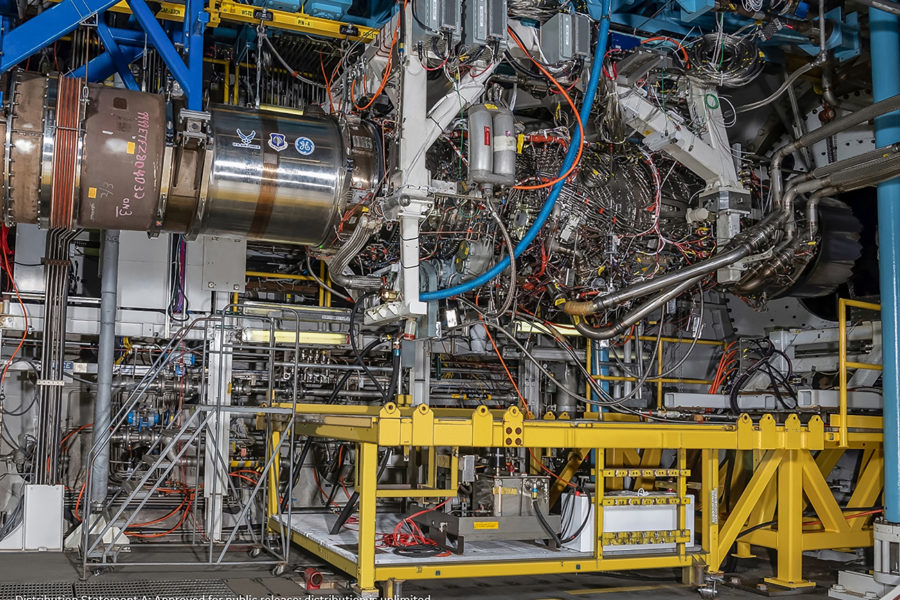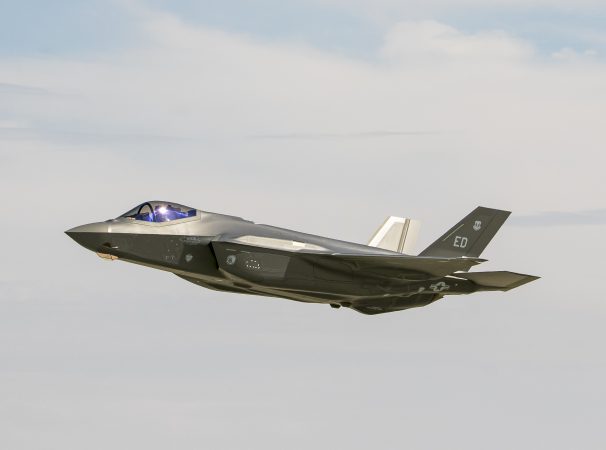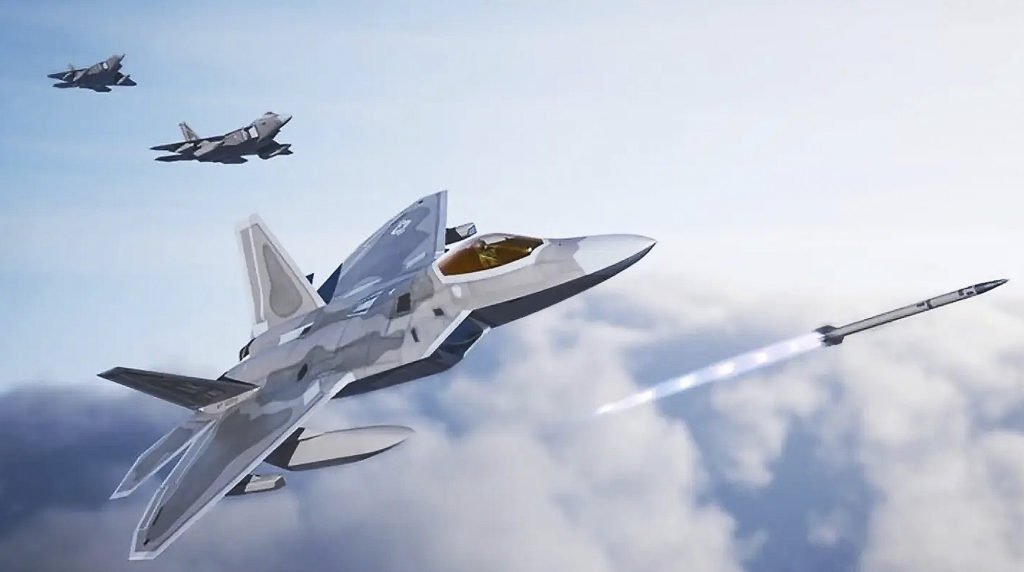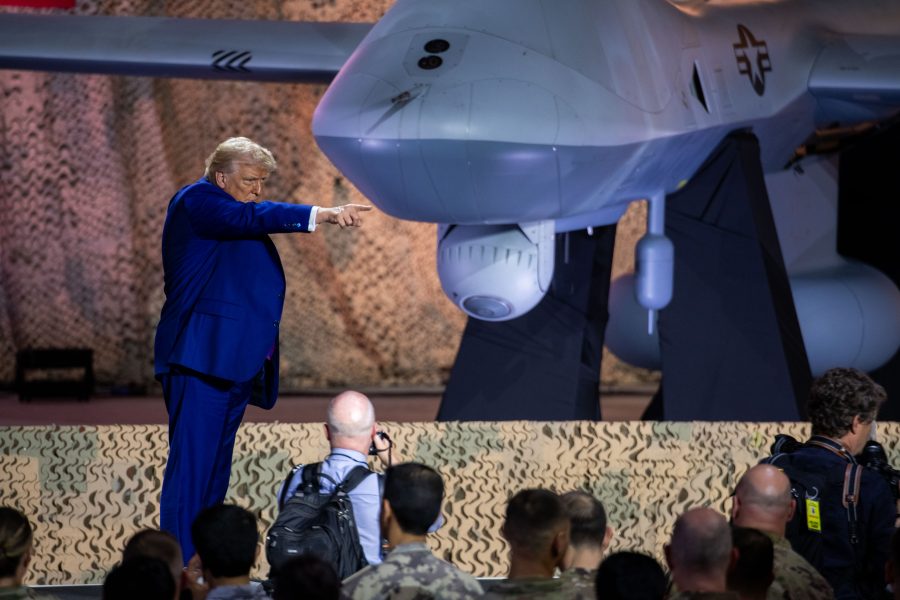President Donald Trump is interested in developing a twin-engined, upgraded version of the F-35 fighter, he said during a press event May 15 in Qatar marking the sale of Boeing airliners and GE Aerospace engines to Qatar Airways. He said he would name the improved aircraft the “F-55” and also referred to a freshly improved F-22 as the “F-22 Super.”
Trump said he’s asked the U.S. military “to look into the F-35.”
“We’re doing an upgrade, a simple upgrade, but we’re also doing … I’m going to call it an F-55, and that’s going to be a substantial upgrade,” Trump said in a surprise announcement.
The future aircraft will have “two engines, because the F-35 has a single engine … I don’t like single engines,” the president said, citing the possibility that one engine “goes out.”
“We’re going to do an F-55, and I think, if we get the right price—we have to get the right price—that’ll be two engines and a super upgrade on the F-35,” Trump concluded.
Development of the F-35 Block 4 upgrade is underway, and its foundational element, the Tech Refresh 3, is in flight test. The program does not call for adding a second engine, however, which would require a radical redesign of the F-35 and make it a much heavier—and likely less maneuverable and shorter-ranged—fighter aircraft. It would effectively be an all-new aircraft requiring extensive design and development, likely at a cost of tens of billions of dollars. The result would be a direct competitor to Boeing’s F-47 Next-Generation Air Dominance fighter, but probably without the F-47’s extremely low observable characteristics.

Trump was seated at the event next to Larry Culp, head of GE Aerospace, which will provide the engines for the Qatar Airways jets, and directed his engine comments at Culp. GE manufactures military as well as commercial engines.
GE pushed hard to be brought on as a second certified engine supplier for the F-35 early in the program and developed, at government expense, an F136 powerplant to compete with Pratt & Whitney’s F135, which is now the sole engine for the F-35. The idea was for the two engine makers to compete for annual buys of F-35 engines, but former defense secretary Robert Gates and Congress killed the F136 in 2011, arguing it was an unnecessary expense.

GE and Pratt also developed the XA-100 and X-101 Adaptive Engine Transition Program (AETP) powerplants as a planned mid-life upgrade for the F-35. But in 2023, senior Pentagon leaders opted not to pursue the more powerful and fuel-efficient engines as a cost-cutting measure. Instead, they opted to go with Pratt’s Engine Core Upgrade (ECU) of the F-35, which is now in development. The rationale for not pursuing the adaptive engines after a decade of work and a $12 billion investment was that powerplants could not be used in all variants of the F-35. The Air Force would have had to fund further refinement and production on its own and couldn’t afford to do so.

Asked if Culp planned to speak with Trump about military engines, a GE Aerospace spokesperson said only that Culp was there to sign and celebrate “the $97 billion contract with Qatar Airways” and could not comment further.
The AETP engine would have increased the F-35’s range by 30 percent, reducing its dependence on aerial tanking, and its acceleration by nearly 20 percent. The adaptive technology would also have helped with the F-35’s heat signature, now becoming a much more important consideration in stealth.
GE and Pratt are now developing competing versions of the Next-Generation Adaptive Propulsion engine, which will build on the previous, unused AETP engine technology and apply it to the F-47 Next-Generation Air Dominance fighter. They are working under matching $3.5 billion contracts. Air Force officials have said that the NGAP will be a smaller engine than the XA-100 or -101, and neither of those can be ported directly to the F-47.
Trump also said he considers the F-22 “the most beautiful fighter jet in the world,” and “we’re going to do an F-22 Super, and it’ll be a very modern version of the F-22 fighter jet.” He remarked that China has “copied it” in that country’s advanced fifth-generation fighter designs, but “they won’t be able to copy our engines too quickly, or anything else.” He added that the F-22 Super is something “I want to do.”
The F-22 is being fitted with advanced missiles, infrared targeting pods, stealthy fuel tanks and pylons, advanced electronics, and other improvements to keep it credible and capable while the F-47 is developed. The upgrade program has no specific name.
Air Force aviation program watchers are unfamiliar with the F-55 and F-22 Super nomenclature. When asked about the F-55 and F-22 Super, the Air Force deferred all inquiries to the White House. The White House National Security Council did not respond to a request for comment when asked to clarify Trump’s remarks. The F-35 Joint Program Office also did not immediately respond to requests for comment.
Lockheed Martin, the prime contractor for both the F-35 and the F-22, said in a statement that it wanted to “thank President Trump for his support of the F-35 and F-22 and will continue to work closely with the Administration to realize its vision for air dominance.” The company declined to comment further and referred additional questions about Trump’s remarks to the White House.

Lockheed Martin CEO Jim Taiclet recently proposed an uprated F-35 as a possible alternative or powerful complement to the new Boeing F-47 on the company’s April 22 quarterly results call. Boeing was selected over Lockheed for the NGAD contract, and Lockheed was eliminated from the Navy’s counterpart program, the F/A-XX, leaving it with the F-35 as its sole major tactical aviation program, which is already 25 years old.
Taiclet said the uprated aircraft would be a “Ferrari” version of the F-35, and achieve 80 percent of the NGAD’s capability at 50 percent of its $300 million-per-copy cost. He did not, however, suggest fundamental changes that would alter the F-35’s mold line or add a new or second engine. A Lockheed Martin spokesperson said the company would not elaborate on Taiclet’s proposal “at this time.”
The F-35 JPO said it had little to share on Taiclet’s proposed upgrade as “this discussion remains entirely notional at this stage.”
Many airpower advocates want the Air Force to improve its fighter fleet in some form.
“Whatever path the Air Force takes on fighter modernization, it is crucial that it secures modern capabilities in sufficient capacity,” said Douglas Birkey, Executive Director of AFA’s Mitchell Institute for Aerospace Studies. “The current fighter inventory is too old, too small, and has been worn hard in constant combat use for decades.”


